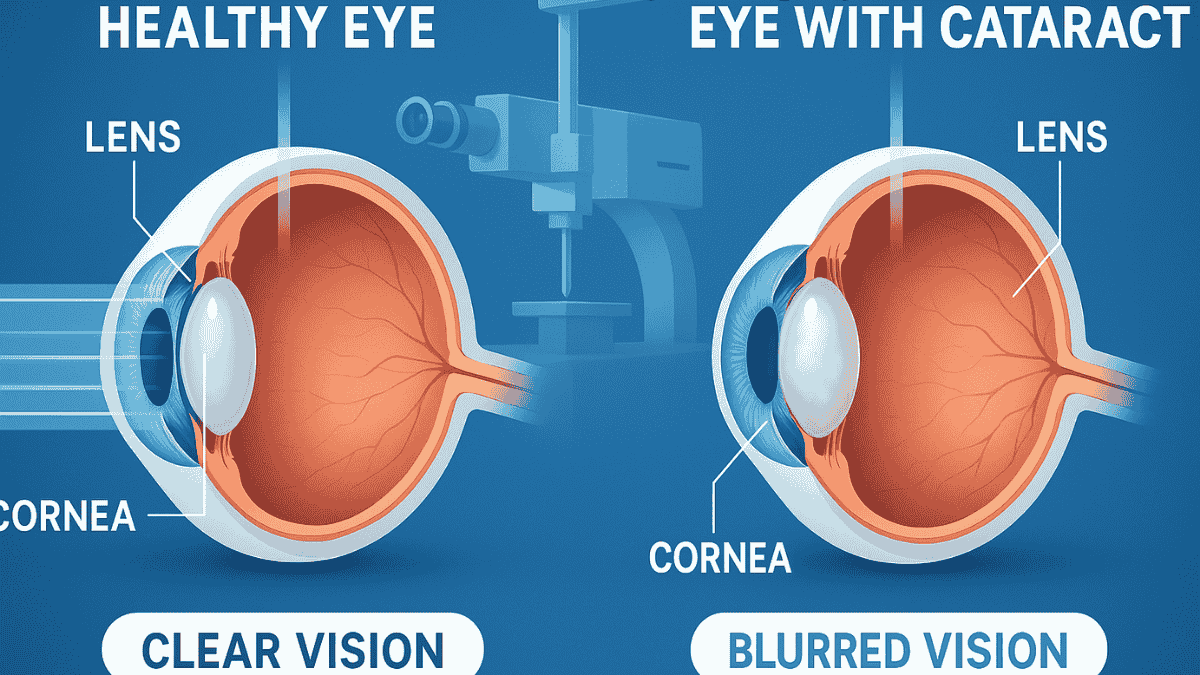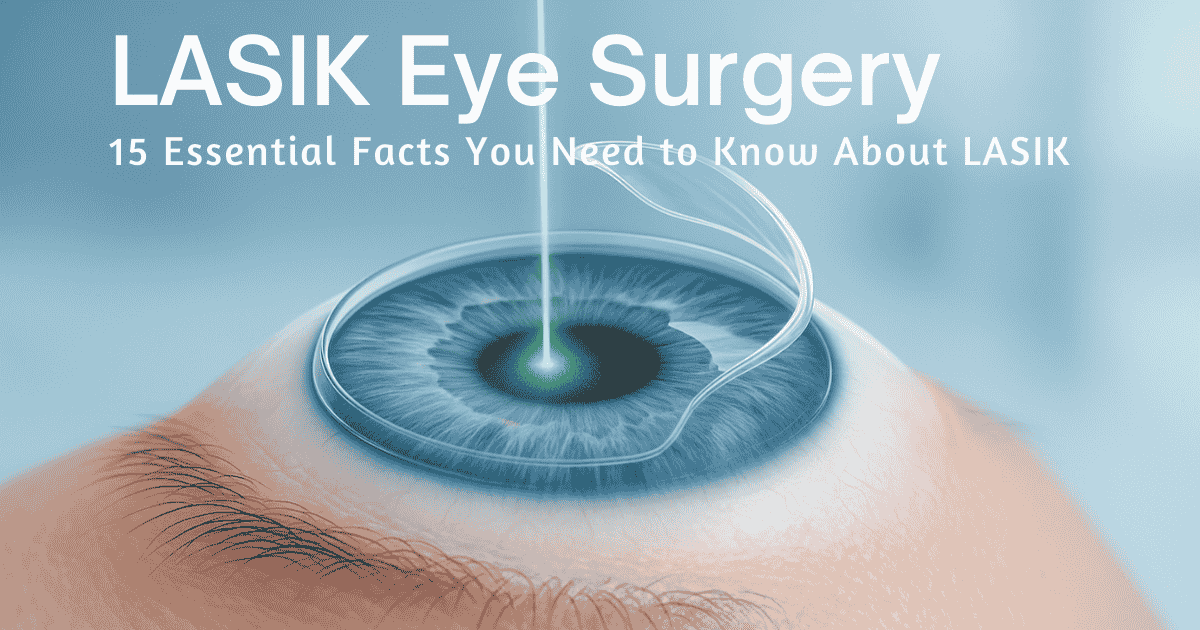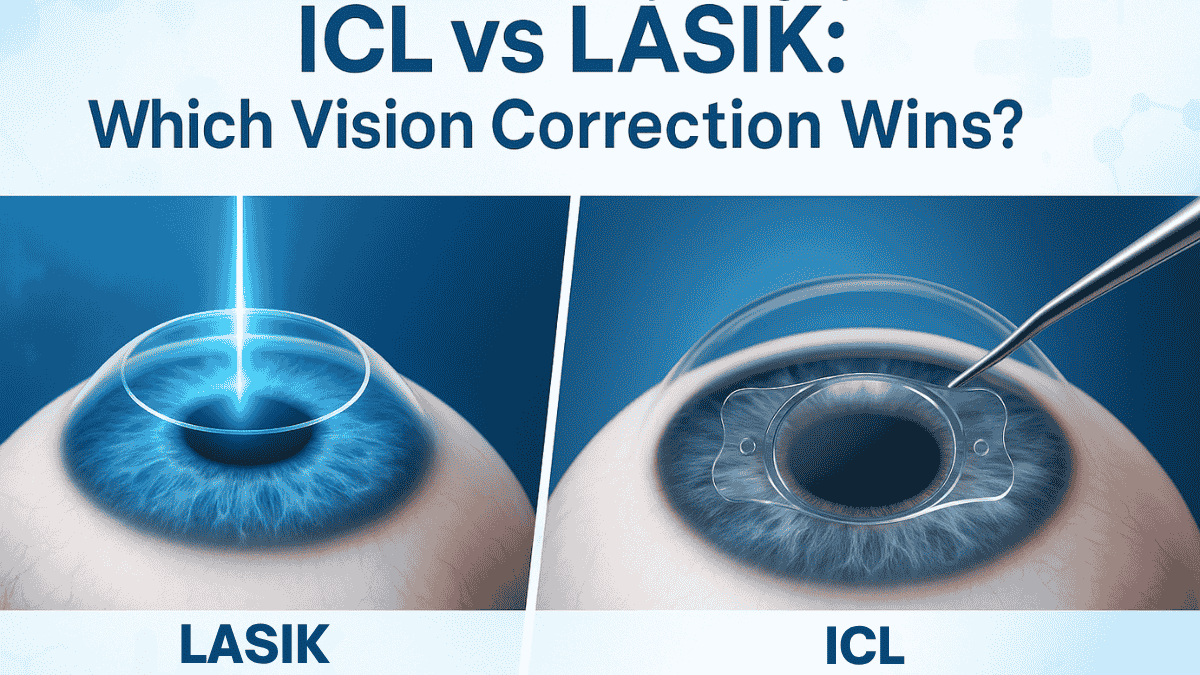
Thinking about getting your vision corrected? You have likely heard about LASIK, a popular option for vision correction, but another effective vision correction procedure, the EVO ICL, is also gaining attention. If you are weighing up ICL vs LASIK, you are in the right place to understand these advanced treatment options. We will break down the key differences to help you make an informed choice about your eye care.
Both ICL surgery and LASIK surgery can give you clearer vision, potentially eliminating the need for glasses or a contact lens. However, these proceaton symptoms. Let’s explore the details of each type of eye surgery.
Table of Contents
What is LASIK?
LASIK, which stands for Laser-Assisted In Situ Keratomileusis, is a well-known type of laser eye surgery. This laser vision correction technique reshapes your cornea, the clear front surface of the eye, to correct common refractive errors. LASIK has been a trusted vision correction procedure since the 1990s and remains a widely performed surgery worldwide.
During a LASIK eye surgery, an eye surgeon creates a very thin, hinged corneal flap on the surface of the eye. An excimer laser is then used to precisely remove corneal tissue, subtly altering the cornea’s curvature to improve how light focuses on the retina. After the cornea is reshaped, the flap is carefully repositioned, where it heals naturally without stitches.
LASIK is effective for many, but the process does involve the removal of corneal tissue, which is a permanent alteration. Understanding the pros and cons of this popular refractive surgery is important for anyone considering it for their LASIK journey. Many people achieve significant vision improvement through this laser vision treatment.
What is ICL?
ICL stands for Implantable Collamer Lens, and it represents a different approach to vision correction. The ICL procedure does not involve reshaping the cornea with a laser. Instead, a specialized, biocompatible lens, often an EVO Visian ICL, is implanted inside the eye by an eye surgeon to correct vision.
This implantable contact lens is made from Collamer, a technologically advanced material derived from collagen that is highly compatible with the body. The collamer lens is positioned between your eye’s natural lens and the iris (the colored part of your eye). It works in harmony with your eye’s natural optical system to provide clear, sharp vision, and it can even offer UV protection.
A key feature of the ICL, sometimes referred to as an implantable contact, is that it does not remove corneal tissue, making it an additive vision correction solution. This means the ICL procedure is often reversible; the lens can be removed or replaced if necessary in the future. This lens surgery is an excellent alternative for certain individuals seeking freedom from contact lenses or glasses.
ICL vs LASIK: Key Differences
Understanding the fundamental distinctions between ICL and LASIK is vital for choosing the best vision correction procedure for your needs. While both aim to improve sight, their methods, applications, and impact on the eye are quite different. These differences can influence who is a suitable candidate and what the long-term experience might be.
Related Article
Pros and Cons of LASIKHow They Work
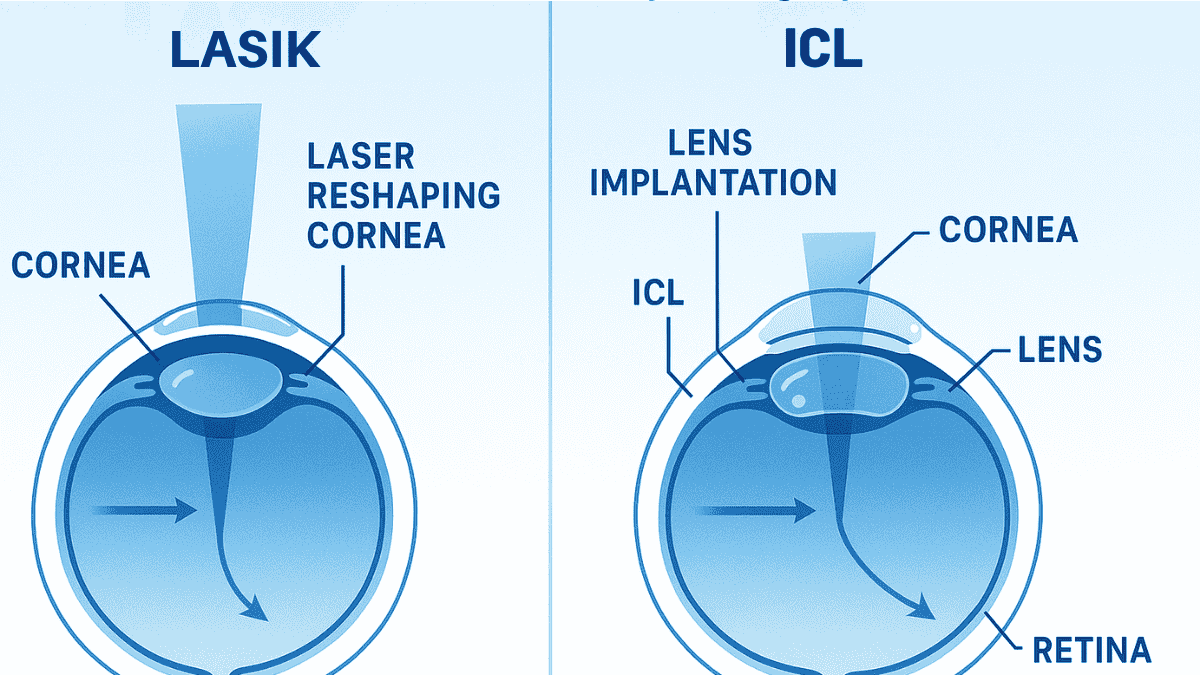
The primary distinction in ICL vs LASIK lies in their mechanism. LASIK surgery permanently changes the shape of your cornea by using a laser to remove corneal tissue. This reshaping corrects the way light rays enter your eye, focusing them properly on the retina to resolve refractive error.
In contrast, the ICL procedure involves implantable collamer lens surgery. This lens, such as the EVO ICL, is added to the eye without altering its natural structures. The implantable collamer lens works with your eye’s natural lens to focus light correctly, and it can be removed if your vision needs change significantly or if other eye health issues arise, like needing cataract surgery later in life.
Who They’re For
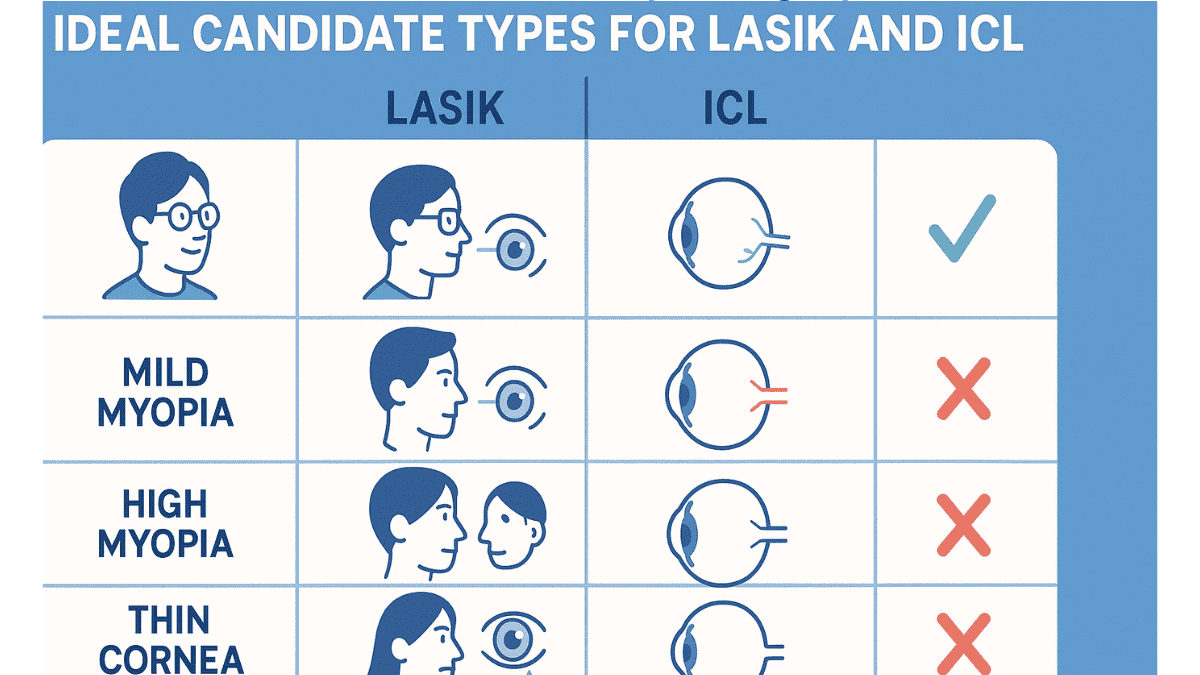
LASIK is generally effective for individuals with mild to moderate degrees of nearsightedness, farsightedness, or astigmatism. However, LASIK suitability depends on factors like corneal thickness; if your corneas are too thin, LASIK might not be the safest option. Your eye doctor will assess your overall eye health before recommending any correction procedure.
ICL surgery, including options like the Visian ICL, often caters to a broader range of prescriptions. It is particularly beneficial for people with higher levels of myopia (nearsightedness) who may not be ideal candidates for LASIK. Additionally, because it doesn’t involve altering the cornea, ICL can be a good choice for individuals prone to dry eyes or those with thinner corneal tissue.
Recovery Time
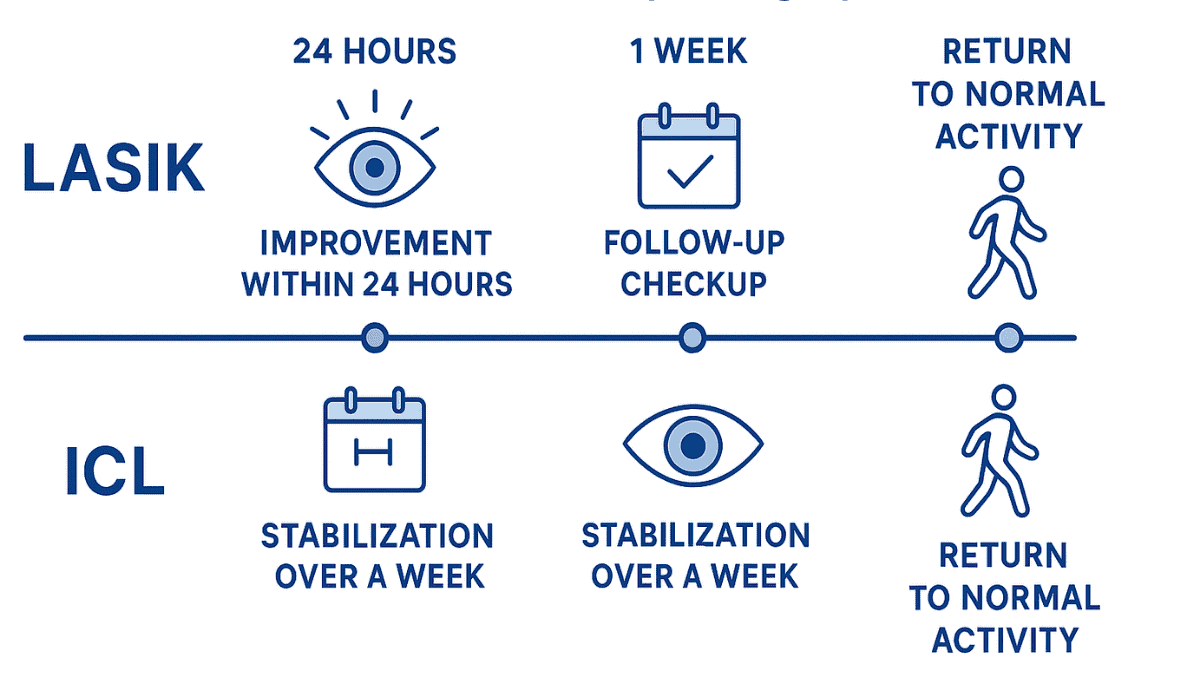
LASIK recovery is often noted for its speed. Many patients report a significant improvement in their vision within 24 hours of the LASIK eye procedure. Most can return to their usual routines relatively quickly, although following post-operative care instructions is important for optimal healing.
The ICL recovery period might be slightly longer for some individuals compared to LASIK. While functional vision often returns rapidly, sometimes within a day or two, complete stabilization and the best visual acuity can take a few days to a couple of weeks. Most people can resume normal activities within a week after their implantable collamer lens surgery.
Here’s a quick comparison:
| Feature | LASIK | ICL |
|---|---|---|
| Procedure Type | Corneal reshaping (laser removes tissue) | Lens implantation (additive) |
| Reversibility | Permanent | Reversible (lens can be removed) |
| Corneal Tissue | Tissue is removed | No tissue removed |
| Ideal Candidate Prescription | Mild to moderate refractive errors | Wider range, including high myopia |
| Dry Eye Impact | Can sometimes cause or worsen dry eyes | Generally does not cause dry eyes |
| Recovery Speed | Very quick, often next-day improvement | Quick, but full stabilization may take longer |
Pros and Cons of LASIK
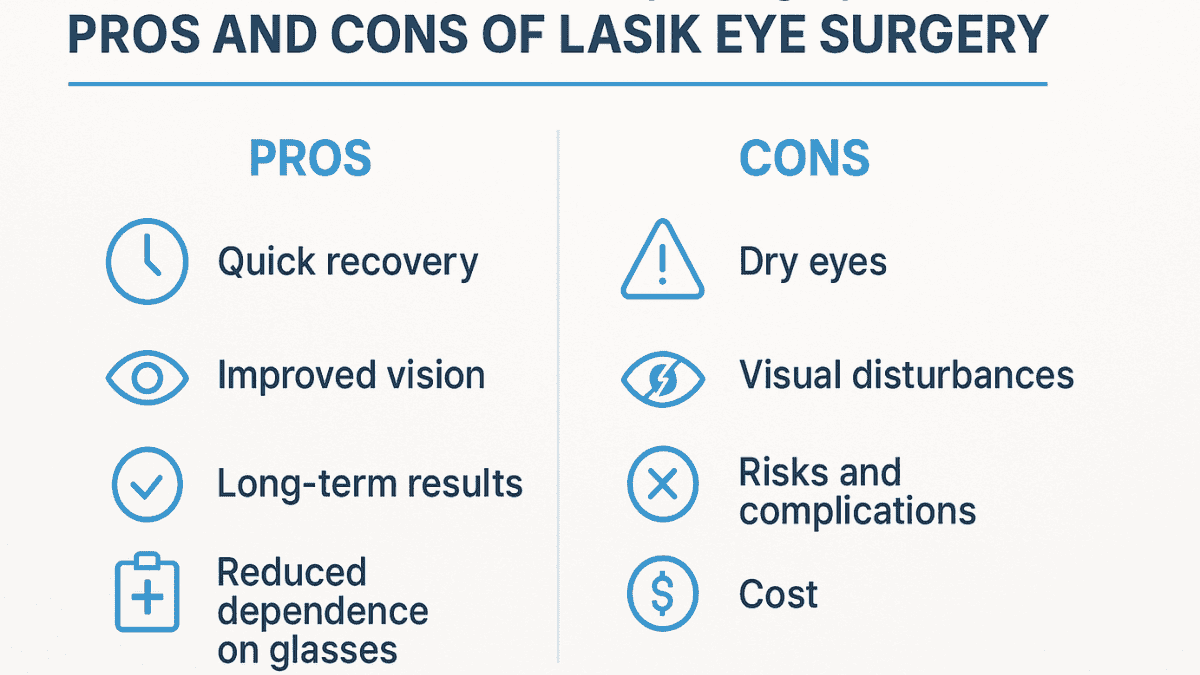
Like any surgical procedure, LASIK eye surgery has its advantages and potential drawbacks. Understanding these pros and cons is a crucial step in deciding if this popular refractive surgery is the right choice for your corrective vision goals. Discussing these with experienced eye surgeons will provide personalized insight.
Pros:
- Quick procedure, typically lasting about 15 minutes per eye.
- Rapid visual recovery for many patients.
- Extensive history of safety and effectiveness; a popular option globally.
- Can correct nearsightedness, farsightedness, and astigmatism.
- The LASIK cost may be lower compared to ICL in many cases.
- High LASIK success rates for achieving improved vision.
Cons:
- Not suitable for individuals with very high refractive errors or thin corneas.
- Can potentially cause or exacerbate dry eye symptoms.
- The change to corneal tissue is permanent and not reversible.
- A corneal flap is created, which carries small, specific risks.
- Some patients may require an enhancement or touch-up procedure later as vision changes with age.
Pros and Cons of ICL
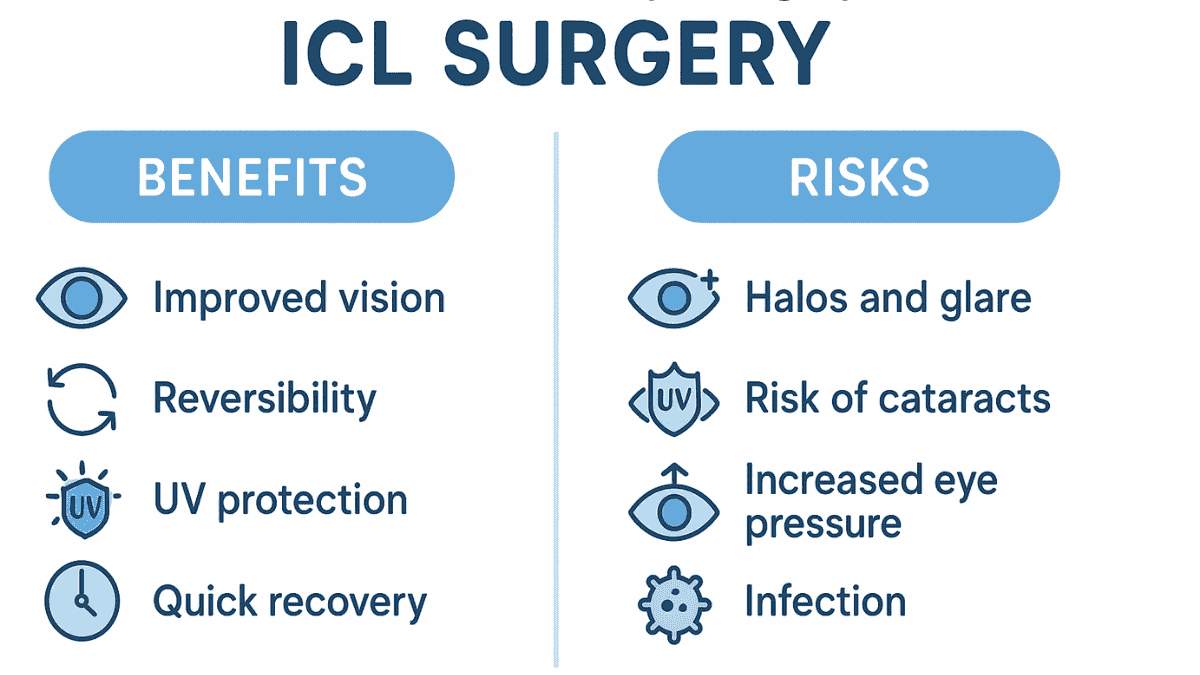
The ICL, particularly the EVO Visian ICL, offers distinct benefits and also has considerations to keep in mind. This lens surgery provides an alternative for those who may not be ideal candidates for LASIK. A thorough consultation can clarify the specific pros cons for your situation.
Pros:
- Can effectively treat a wider range of prescriptions, including very high myopia, than LASIK.
- The procedure is reversible; the implantable collamer lens can be removed or exchanged if needed.
- Does not remove corneal tissue, preserving the eye’s natural structure.
- Generally does not cause or worsen dry eye syndrome, making it a good option for those with pre-existing dry eyes.
- The collamer lens material offers UV protection.
- May provide sharper, clearer vision, especially for those with high prescriptions.
Cons:
- The ICL procedure is more invasive than LASIK as it involves placing a lens inside the eye.
- The icl costs are typically higher than lasik costs.
- ICL recovery, while generally smooth, may involve a slightly longer period for full visual stabilization.
- There is a very small risk of developing cataracts earlier or an increase in intraocular pressure, requiring monitoring.
The Advanced Technology of ICLs
The technology behind the Implantable Collamer Lens (ICL) is a significant factor in its growing appeal. The lens itself, often an EVO ICL or EVO Visian ICL, is a product of advanced ophthalmic engineering. It’s crafted from Collamer, a unique material that contains a small amount of purified collagen, making it highly biocompatible with the eye.
This biocompatibility means the implantable collamer lens is generally well-tolerated, minimizing the risk of rejection or adverse reactions within the eye. The Collamer material also has inherent UV-blocking properties, offering an extra layer of protection to the eye’s natural lens and retina. The design of lenses like the EVO Visian often includes features that promote healthy fluid flow within the eye, which is why newer models usually don’t require a pre-operative iridotomy.
The ICL procedure involves placing this sophisticated implantable contact lens strategically within the eye, either between the iris and the natural lens or in front of the iris, depending on the specific lens type. This precise placement allows the ICL to work in conjunction with the eye’s natural focusing system. The development and refinement of the collamer lens through extensive clinical trials have established it as a safe and effective vision correction option, especially for those who are not ideal candidates for laser vision correction procedures like LASIK.
Who’s a Good Candidate for LASIK?
Determining if you are a good candidate for LASIK surgery involves a comprehensive eye examination and consultation with an eye doctor. Generally, LASIK might be a suitable vision correction procedure if you meet certain criteria. Good eye health is fundamental for any elective eye surgery.
LASIK is often recommended if:
- You are at least 18 years old, and your vision prescription (refractive error) has been stable for at least one year.
- You have mild to moderate nearsightedness, farsightedness, or astigmatism.
- Your corneas are sufficiently thick to allow for the creation of a corneal flap and tissue removal.
- You do not have severe dry eye syndrome or other significant eye conditions like untreated glaucoma management issues or advanced macular degeneration.
- You have realistic expectations about the outcomes of laser eye surgery.
An eye surgeon will perform several tests to assess your LASIK suitability and discuss whether LASIK is the best way to achieve your desired corrective vision.
Who’s a Good Candidate for ICL?
The ICL, including the EVO ICL, can be an excellent alternative if LASIK is not recommended for you. Suitable candidates for ICL surgery also need a thorough evaluation by an experienced eye surgeon. This lens surgery opens up possibilities for many seeking freedom from glasses or contact lenses.
ICL could be a better choice if:
- You are generally between 21 and 45 years of age.
- You have a moderate to high level of nearsightedness (myopia) that may be beyond the effective treatment range of LASIK. Some ICLs can also correct astigmatism.
- Your corneal tissue is too thin for the LASIK procedure.
- You suffer from dry eye syndrome, as ICLs do not typically worsen this condition.
- You desire a reversible vision correction option.
The EVO Visian ICL has received FDA approval for a wide range of prescriptions, offering a viable path to clear vision for many individuals. Your eye care professional will help determine if this implantable contact lens is the right fit.
The Procedures: What to Expect

Knowing what happens during each vision correction procedure can help alleviate concerns. Both LASIK and ICL are typically performed as outpatient surgeries, meaning you can go home the same day. However, the specifics of each surgery differ.
LASIK Procedure
The LASIK eye procedure is known for its efficiency. Here’s a general outline of what happens during lasik surgery:
- Your eye will be numbed using anesthetic eye drops; no injections are usually needed. You will be awake during the procedure.
- A specialized instrument or a femtosecond laser is used to create a precise, thin corneal flap on the surface of your eye.
- You will be asked to focus on a target light while an excimer laser, guided by a computer, reshapes the underlying corneal tissue. This part of the laser vision correction takes only seconds.
- The surgeon then carefully repositions the corneal flap, which begins to heal naturally and adheres without stitches.
The entire LASIK process usually takes about 10-15 minutes per eye. You will likely notice improved vision quite soon after the laser eye treatment.
ICL Procedure
The ICL procedure, or implantable collamer lens surgery, is also an outpatient procedure but involves placing a lens inside the eye rather than reshaping the cornea. Here’s what the collamer lens surgery typically involves:
- Your eye is numbed with anesthetic drops or, in some cases, a local anesthetic injection. You may also receive a mild sedative to help you relax.
- The eye surgeon makes one or two very small incisions at the edge of your cornea. These incisions are self-sealing and usually do not require stitches.
- The folded EVO ICL (or other chosen implantable collamer lens) is carefully inserted through the small incision.
- Once inside the eye, the lens gently unfolds and is meticulously positioned by the surgeon, typically behind the iris and in front of your eye’s natural lens.
This lens surgery generally takes about 20-30 minutes per eye. You will need someone to drive you home after the ICL procedure.
Recovery and Results
The recovery process and visual outcomes can vary between LASIK and ICL. Both procedures boast high success rates in achieving improved vision, but understanding the typical recovery timeline is important. Your adherence to post-operative instructions plays a big part in your healing and final results.
LASIK Recovery
After LASIK eye surgery, it’s common for your eyes to feel a bit gritty, scratchy, or watery for a few hours or days. Some light sensitivity is also normal. Most people experience a noticeable improvement in their vision within the first 24 hours, with many achieving good functional vision the very next day.
You will be prescribed eye drops to prevent infection and reduce inflammation. It is important to avoid rubbing your eyes and to attend all scheduled follow-up appointments with your eye doctor. Full visual stabilization after LASIK can take a few weeks to a few months, with high LASIK success in achieving 20/20 vision or better for many suitable candidates.
ICL Recovery
The ICL recovery period is also generally smooth. Your vision might be somewhat blurry or hazy immediately after the ICL surgery, but it typically clears up significantly within a day or two. Some patients report seeing well almost immediately, while for others, optimal vision may take a few days to a week or so to stabilize.
Similar to LASIK, you will use medicated eye drops for several weeks to aid healing and prevent complications. Strenuous activities and eye rubbing should be avoided during the initial ICL recovery phase. Many ICL patients achieve excellent visual acuity, often comparable to or even sharper than what they experienced with their best contact lenses, particularly those with high refractive errors.
Understanding Risks and Safety

Both LASIK and ICL are considered safe surgical procedures when performed by experienced eye surgeons on suitable candidates. Devices like the EVO Visian ICL have received FDA approval after extensive clinical trials demonstrated their safety and effectiveness. However, as with any surgery, potential risks and complications exist, although they are rare.
For LASIK, risks can include dry eyes (often temporary), glare, halos around lights, and issues related to the corneal flap. In very rare cases, more significant complications like infection or vision loss can occur. The overall LASIK safety record is excellent, with millions of successful procedures performed worldwide.
For ICL surgery, potential risks include inflammation, increased intraocular pressure (which is usually temporary and manageable), and a very small long-term risk of developing cataracts or endothelial cell loss. The EVO ICL design helps mitigate some earlier concerns, and careful pre-operative screening by your eye doctor helps identify individuals who might be at higher risk. Discussing the specific risks with your eye surgeon is important.
Costs: ICL vs LASIK

The cost is an important factor when considering vision correction procedures. Generally, LASIK is less expensive than ICL surgery. The average LASIK cost can range from approximately $2,000 to $3,000 per eye. The average ICL costs are typically higher, ranging from about $3,500 to $5,000 or more per eye.
These figures are general estimates; the actual cost for either procedure can vary based on several factors. These include the surgeon’s experience, the specific technology used (e.g., advanced lasers for LASIK, specific types of ICLs like the EVO Visian), the complexity of your refractive error, and the geographic location of the clinic (costs in cities like Los Angeles might differ from other areas). Pre-operative assessments and post-operative care are usually included in the overall fee, but it’s good to confirm what the LASIK costs or ICL costs cover.
Vision correction procedures like LASIK and ICL are usually considered elective, so they are often not covered by standard health insurance plans. However, many eye care clinics offer financing options or payment plans to help make these life-changing procedures more accessible. Some employers offer flexible spending accounts (FSAs) or health savings accounts (HSAs) that can be used for these expenses.
Long-Term Considerations
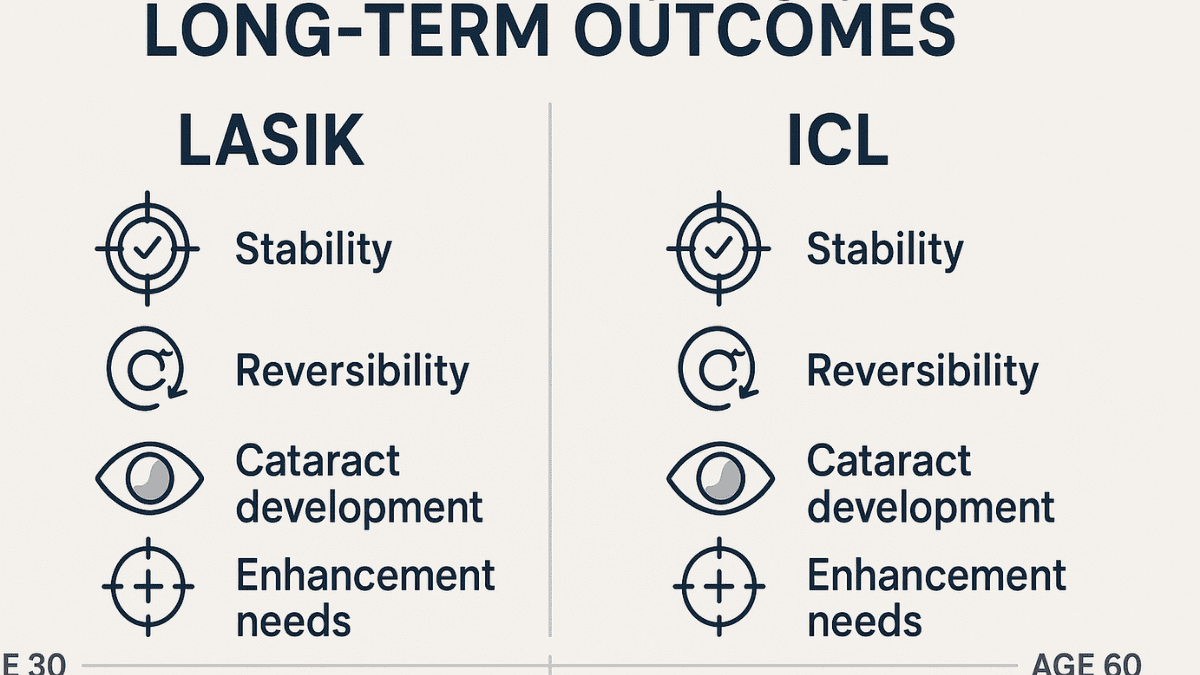
Thinking about the long-term effects of your chosen vision correction is sensible. Both LASIK and ICL are designed to provide lasting vision improvement, but your eyes and vision can naturally change over time. Understanding these potential long-term aspects helps in setting realistic expectations.
LASIK Long-Term Effects
The results of LASIK are generally very stable for many years. However, vision can naturally change with age due to processes unrelated to the LASIK procedure itself. Some individuals may experience a gradual shift in their prescription over time, which might necessitate an enhancement procedure (a LASIK touch-up) years later, although this is not common for everyone.
As you get older, typically around your mid-40s, you will likely develop presbyopia, a natural age-related condition that affects near vision, causing the need for reading glasses. LASIK corrects distance vision primarily and does not prevent presbyopia. Maintaining good eye health through regular check-ups with your eye doctor is important after LASIK, as with any vision correction.
ICL Long-Term Effects
ICL results also tend to be very stable over the long term, providing consistent corrective vision. One of the advantages of the ICL is that if your vision changes significantly or if you develop other eye conditions like cataracts, the implantable collamer lens can be removed or replaced. This adaptability is a key feature of this lens surgery.
The collamer lens is designed to remain in place and function effectively for a lifetime. There is a small statistical association with earlier cataract development in some ICL patients, though this risk is low, particularly with newer lens designs like the EVO ICL. The ICL does not affect the eye’s natural lens directly, but it resides in proximity to it.
Considering Other Eye Conditions and Treatment Options
When deciding between ICL and LASIK, your overall eye health and any pre-existing conditions are important considerations. Conditions like chronic dry eye, early signs of macular degeneration, or existing glaucoma management plans can influence which vision correction procedure, if any, is most appropriate for you. A thorough eye exam will assess for these issues.
For example, if you have significant dry eyes, ICL surgery might be preferred over LASIK, as LASIK can sometimes temporarily worsen dry eye symptoms. If you are older and already showing signs of cataracts, neither ICL nor LASIK may be the primary recommendation. Instead, a procedure like refractive lens exchange (RLE), which involves replacing the eye’s natural lens with an artificial one (similar to cataract surgery), might be a more suitable treatment option to discuss with eye surgeons.
Alternatives like SMILE Pro (Small Incision Lenticule Extraction) represent another type of laser vision correction, which is less invasive than LASIK in some ways as it doesn’t create a flap. While ICL and LASIK are popular choices, your eye doctor can explain all relevant treatment options based on your individual eye health and vision needs. Some techniques, like corneal cross-linking, address corneal stability rather than refractive error but might be relevant for overall eye care discussions if certain conditions are present.
Making Your Decision: ICL vs LASIK
Choosing between ICL and LASIK is a significant decision that should be made after careful consideration and professional guidance. There are several key points to weigh as you evaluate these advanced treatment options for vision correction. The goal is to select the correction procedure that best aligns with your visual needs, lifestyle, and overall eye health.
Here are some crucial factors to consider:
- Your Prescription: If your refractive error is very high, particularly for nearsightedness, ICL might offer a better visual outcome.
- Your Corneal Thickness: Thin corneas may make you a less suitable candidate for LASIK, pointing towards ICL as a potential alternative.
- Your Budget: LASIK is generally more affordable than ICL. Understanding lasik costs versus icl costs, including any financing, is important.
- Your Comfort Level: Some individuals prefer the concept of an additive and reversible procedure like ICL, while others are comfortable with the corneal reshaping involved in LASIK.
- Presence of Dry Eye: If you have pre-existing dry eye syndrome, ICL is often favored as it doesn’t typically exacerbate the condition.
Remember, the best choice depends entirely on your individual eye characteristics, your specific vision symptoms, and a detailed discussion with qualified eye surgeons. An expert will evaluate your eye’s natural lens, corneal health, and other factors to recommend the safest and most effective vision correction procedure for you.
Conclusion
When it comes to ICL vs LASIK for vision correction, there isn’t a single answer that fits everyone. Both the EVO ICL and LASIK surgery are remarkable procedures that can substantially improve your vision and enhance your quality of life, reducing or eliminating dependence on glasses or contact lenses. LASIK is a popular option with a long history and is often a more economical choice, while ICL can treat a broader range of refractive errors and offers the benefit of reversibility without altering corneal tissue.
The right decision hinges on a comprehensive evaluation of your eyes, your lifestyle needs, and your personal preferences regarding treatment options. A thorough eye examination and an in-depth consultation with a qualified eye surgeon are essential to determine which popular refractive surgery—ICL or LASIK—is the most suitable and safest surgical path for your journey towards clearer vision. Whether you opt for an implantable collamer lens or laser vision correction, you could soon experience the freedom that improved sight brings.
The primary difference between ICL vs LASIK lies in the surgical approach—LASIK reshapes the cornea using a laser, while ICL involves implanting a lens inside the eye without altering corneal tissue.
For individuals with high levels of nearsightedness, ICL is often considered safer than LASIK, as it doesn’t require corneal thinning and offers a reversible vision correction option.
When comparing ICL vs LASIK for long-term outcomes, both are stable, but ICL offers the advantage of reversibility and potentially fewer dry eye symptoms.
Yes, that’s one of the main benefits in the ICL vs LASIK debate—ICL lenses can be removed or replaced if your vision or eye health changes.
LASIK may worsen dry eye symptoms, while ICL is typically preferred for patients with existing dry eyes because it doesn’t disrupt corneal nerves.
In the ICL vs LASIK cost comparison, ICL is usually more expensive due to the implantable lens and more complex procedure.
Many patients report sharper vision with ICL vs LASIK, especially those with high prescriptions, due to the optical precision of the implanted lens.
LASIK recovery is faster, often showing improvement within 24 hours. ICL recovery is also quick but may take a few days longer to fully stabilize.
When evaluating ICL vs LASIK risks, both are safe but carry different complications—LASIK may cause dry eyes and flap issues, while ICL carries a small cataract risk.
Yes, in some cases, patients may receive ICL after LASIK if their vision deteriorates and they meet anatomical requirements.
Absolutely. In the ICL vs LASIK suitability discussion, ICL is preferred for patients with thin corneas, as it does not rely on corneal reshaping.
Yes, both procedures can correct astigmatism. However, ICL lenses specifically designed for astigmatism may be more suitable for certain patients.
LASIK is more widely performed globally, but ICL is gaining popularity due to its flexibility and improved technology.
Typically, neither ICL nor LASIK is covered by insurance, but financing options may differ between the two procedures.
LASIK usually takes less time—around 10–15 minutes per eye—compared to ICL, which can take 20–30 minutes due to the implantation process.
Yes, especially in patients with high prescriptions, ICL may offer more stable vision than LASIK over many years.
ICL lenses can be removed if cataract surgery is needed, while LASIK-altered corneas may complicate future lens calculations slightly.
Both require post-op checkups, but ICL may involve more early monitoring due to the nature of the implant and intraocular procedure.
Some patients report better contrast sensitivity and night vision with ICL vs LASIK, especially in high-prescription scenarios.
ICL offers more customization in lens selection, while LASIK customization depends on corneal mapping and laser technology.
Sources
AAO – ICL Lens OverviewSources
FDA – ICL Device Approval

